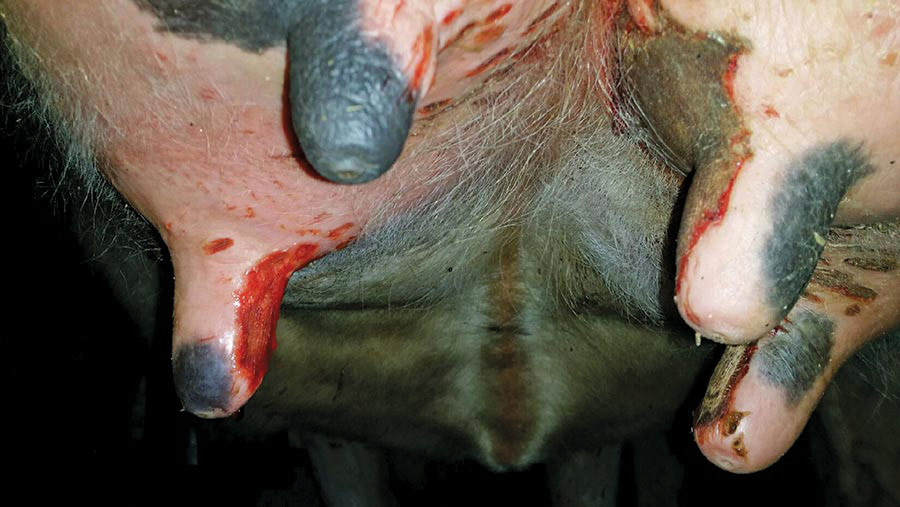Ischaemic teat necrosis advice updated as new causes found
 © Al Manning
© Al Manning A teat disease that causes intense irritation to cows looks likely to be caused by an imbalance of bacteria, rather than just one pathogen.
This is the conclusion of a study by AHDB and the University of Liverpool School of Veterinary Science, which followed 250 cases of ischaemic teat necrosis (ITN).
ITN often results in extensive self-licking, with some cows removing teats from their udders.
See also: Video: Herdsman’s tips on beating ischaemic teat necrosis
Rather than being linked with digital dermatitis (DD), as previously thought, researchers now believe ITN could be caused by an imbalance – or dysbiosis – in bacterial strains on the udder.
Healthy udders have a very diverse population of bacteria, while ITN cases had udders with more dominant bacterial species, the study showed.
The researchers analysed 137 ITN samples and carried out a metagenomics study on the bacteria involved. There were also vet discussions, a national farmer questionnaire and farmer interviews.
Previously, a pilot study on cows across 10 mainland UK farms linked DD treponemes with ITN, after finding treponemes on 11 of 12 samples.
Of 250 ITN cases
- 52 (20%) cases recovered
- 57 (22.8%) were culled for losing one or two teats or developing a secondary health issue, such as toxic mastitis
- 141 (56.4%) either lost a teat or milked on a reduced number of teats
But Hayley Crosby-Durrani, lead researcher, veterinary pathologist and PhD student, told the AHDB Dairy Research Conference last week (22 November) that ITN could not be linked with one common bacterial agent.
“We had farms with ITN that have never had digital dermatitis or have not had it for many years,” she told Farmers Weekly.
“But, if there is a problem with DD on the farm, the DD treponemes could possibly get into a cracked teat and stop the tissue healing.”
Advice
- Focus on heifers ITN is known to be most prevalent in first-lactation dairy heifers, so check the front and back of the teats at every milking
- Catch it early Cases can recover if the teat is identified early and kept clean, moist and supple. Stop milking the affected quarter to allow time to heal. Any moisturiser can work, and pain relief is important, although antibiotics, even topical ones, have little impact.
Potential risk factors
- Chapped teats Any rough skin or breaking of the teat surface is a potential risk factor for ITN. Teat inspections should be undertaken to check on the teats, the vacuum pressure of the milk cluster and the post-milking routine and teat dip
- Udder cleft dermatitis This looks like a scab on the cleft between the two halves of the udder or between the udder and the belly. It appears that having udder cleft dermatitis in older cows in the herd increases the risk for ITN in first lactation heifers.
